Enlighten Survey
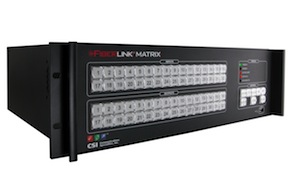
In order to shed a different light on the subject of fiber optics, SCN has conducted a survey with some of the top manufacturers based on a single, simple question at the heart of any large installation in which fiber is a consideration: “When does it make "cents" to use photons in lieu of electrons?” Here’s some of what they had to say:Derek Miranda, Director of Marketing, Communications Specialties Inc.

- CSI Fiberlink Matrix.In today's mixed format, high-bandwidth environments, it always makes sense to consider a fiber link. There are two critical distinctions to make when comparing copper and fiber. The first is that fiber optics transmits light, not electricity. It is completely unaware of the signal type being transmitted. The same cabling can be utilized to transmit 3G-SDI, DVI, audio, data; individually, all together; in one direction or in both directions on one strand of single mode fiber. Single mode fiber has a virtually unlimited bandwidth capacity. It can support the high bandwidth resolutions of today and the exponentially higher bandwidth signals of tomorrow. This means that the infrastructure is future proofed and does not need to change (or change very little) as a facility’s specific requirements evolve. The second is cost. Single mode fiber is now cheaper than Cat-5 cabling. But the cost savings go beyond the cable itself. The savings continue to compound as you leverage each of the capabilities of fiber as described in point 1.
- Paul Hand, product manager, AMX:
AMX Epica DGX Switcher.It stands to reason that the inherent benefits of fiber signals revolve around those characteristics found by using an optical distribution system, mainly that we’re using light instead of an electric signal to pass data. Ultimately, the decision to use copper versus fiber is a cost/benefit analysis, which will consider the added cost of an optically based distribution solution, versus the benefits provided by this type of platform. Those benefits are typically tied to optical transmission lines in general. Optical lines are significantly more difficult to tap, cut (without interruption of service), or otherwise tamper with. They also provide electrical isolation, which prevent back channel communications possibilities when using single direction optical components. It is impossible for transient voltages to pass between optically linked buildings or environments. Fiber prevents ground loops from occurring between connected environments. Because optical paths are immune to any outside electrical noise or interference, they are ideal for areas where these environmental factors are present and otherwise could negatively affect effective video runs. Even when compared to alternative category cable solutions, optical signals are the lightest, highest density solution available, especially when using multiple optical cable bundles. Longer distances with pixel for pixel reproductions is perhaps still the most compelling reason for the use of fiber.
Steve Dupaix, director of marketing, routers and signal management, Grass Valley:
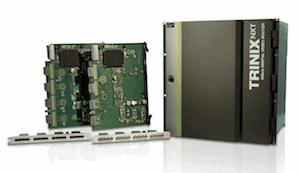
Grass Valley Trinix NXT.There are three key factors in choosing fiber over coax: bandwidth, distance, physical infrastructure. With the straight-line costs of installing and maintaining fiber solutions still in the range of 3 to 5 times the cost of installing coax, it might appear that coax should still be the preferred solution in the broadcast facility – and it is. But when you consider the bandwidth requirements of base-band, full resolution 1080P (3Gbps), the attenuation rates per foot of coax at these data rates, and the sheer size and weight of thousands of coax cables, fiber quickly becomes an attractive alternative. The following three examples illustrate this:
While recently evaluating an upgrade at a large facility, we became aware that the amount of copper cabling in parts of the building was reaching the maximum load-bearing capacity of the physical infrastructure. The cost of adding additional reinforcement and support for a coax expansion was far in excess of the cost difference between the copper and fiber solution. Additionally, with the initial investment into a fiber solution covered, replacement of a significant portion of the existing copper with fiber became practical, resulting in a more structurally sound installation that has the ability to accommodate additional expansion in the future.
In another facility expansion project, the customer had run out of studio and production space in their current building and needed to expand into an adjacent building. While the distance between the buildings was within the 140 meters of Belden 1694A equalization capabilities of our Trinix NXT router, the cost of tearing up concrete or drilling the required numbers of conduit holes between the buildings was quite high. When comparing the cost of these options against the cost of drilling a single conduit hole for a fiber solution capable of supporting any possible expansion needs now and in the future, the fiber solution resulted in a significant savings to the customer as well as a much faster integration time.
Finally, in very large structures the cost of using the very best large-diameter copper solution begins to approach the integration cost of fiber. Add to this the capabilities of CWDM on the fiber solution and the choice becomes obvious. In numerous cases, the mix of electrical and optical in a single broadcast router has enabled the customer to enjoy the benefits and cost savings of both 140 meters of copper and the 40-kilometer capabilities of fiber to reach any point within the facility, as well as campus wide locations.
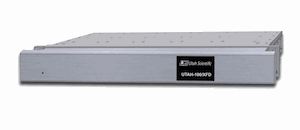
Utah Scientific Utah-100/XFD.
Fiber optic links are increasingly popular in digital video applications these days due to two converging factors: the data rates required for digital video are increasing, and the cost of fiber links is decreasing. The typical 75-ohm coaxial cables used to carry digital video signals have a distance limitation of about 300 meters for standard definition and 100 meters for high definition signals. While HD equipment is now generally able to stretch the distance limit to 140 meters or so, the increasing use of 1080p high definition signal formats means that the 100 meter limit is really the practical maximum for carrying these signals over coax. This means that alternative transport links must be found for campus applications and even for longer runs within large buildings.
Hagai Gefen, president and CEO, Gefen:
A daily selection of the top stories for AV integrators, resellers and consultants. Sign up below.

Gefen DVI FM-1500.
Basically, it’s best to use fiber optics when you want to run long distances, beyond a hundred meters. Fiber is also the best when you’re operating in an environment with heavy EMI (electromagnetic interference) because it protects the signal transmission better than any other cable. Advances in copper have come a long way, however, and copper can be used in 100 meter or less installations with an excellent signal transmission. Gefen’s fiber-based solutions come in sender/receiver systems with pre-terminated fiber optic cables and advanced features like locking HDMI connectors…The GefenPRO DVI FM-2000 is currently the only solution to send dual link DVI resolutions long distance over fiber optic cables.
Steven Barlow, president, DVIGear:

DVIGear DVI-7330.In general, [using optical distribution products over copper] makes tremendous amounts of sense in many ways. Copper solutions are usually limited to 200 to 300 feet, whereas optical extenders can transport the signal many miles if need be. Optical solutions tend to be much more immune to RFI/EMI problems. In addition, they have a much lower RFI/EMI footprint, which makes them ideal for sensitive applications. Optical cables are quite small and lightweight and are much easier to pull through a conduit than copper cables…It is harder to find DVI and HDMI copper cables with plenum rating. Optical cables with plenum ratings can be less expensive. Generally speaking optical extender solutions have the possibility to support higher bandwidth than copper cables. This correlates into support for higher bit rates (high resolutions) as well.
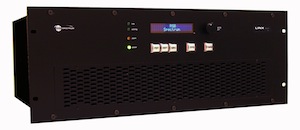
RGB Spectrum Linx F.JX Loeb, product marketing manager, RGB Spectrum:
Many designers and installers know the advantages of fiber compared to copper for video distribution: Fiber runs are not subject to interference from other equipment; multiple runs of fiber can be pulled through even when conduit or plenum rated fiber is available; it’s much lighter than copper (no pun intended); even multimode fiber can go hundreds of meters and single mode can go 20 kilometers or more. So fiber makes sense when security is a concern, distances exceed those available with category cable, no frame drop of HD resolution signals can be tolerated, and when best possible image quality is needed.
Andrew Evans, product marketing manager, Extron:
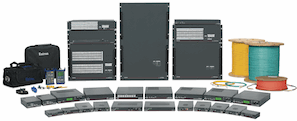
Extron's family of fiber optic solutions.Historically, fiber optics has been the infrastructure of choice for operations centers and government applications, which require secure signal transmission or overcoming moderate to extreme distances. That part hasn’t changed. However, with the increased adoption of very high-resolution digital signals and the incorporation of HDCP-encrypted content, fiber optic-based solutions have become well suited for a wider variety of environments, such as commercial and medical installations. AV system designs with Extron multimode or singlemode fiber optic infrastructures provide pixel-for-pixel transmission, regardless of resolution and distances. For example, multiple video inputs of various types (e.g. HDMI, DVI, RGBHV, and HD component video) can be routed through a fiber optic matrix switcher, then scaled by the receiver to the native resolution of each display.
Tony McAhren, Product Manager at TV One:
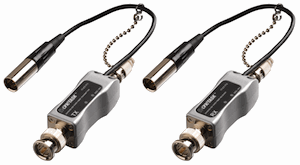
TV One 1T-CT-770.TV One’s One Task fiber distribution products allow for longer signal paths while maintaining signal integrity, which is particularly useful when high-resolution 1080p is needed in places where distances range from 1,000 feet to 18.6 miles. The ability to send high quality 12bit v1.3 HDMI with HDCP along with embedded lossless audio over a single fiber optic cable distance up to 3,280 feet or a 3G/HD/SD-SDI signal re-clocked at a distance of up to 18.6 miles allow for easy installation without the worry of interference or signal quality loss, at reasonable prices, which are components of a desirable system installation in today’s marketplace.
Brian Macauto, Magenta Research, product manager of voyager:
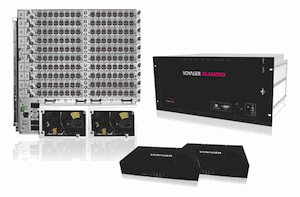
Magenta Research Voyager Products.The cost of installing fiber-optic based content delivery systems is dropping every year, thanks to innovations like easy crimping fiber ends (which make it relatively simple to terminate fiber in the field) and technology developed specifically for the Pro AV market by manufacturers like us. Today, fiber-based signal extension, switching, and distribution solutions—at least from Magenta—are priced extremely competitively with our UTP-based analog systems. Additionally, when selecting fiber as an infrastructure, the slightly higher cost can be offset by the supplementary headroom available for future applications and video standards.
Bob Rapoport, sales and marketing director, PureLink:
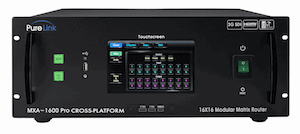
PureLink MXA-1600.PureLink believes that all HD content at 1080p should be extended over fiber optics, not copper. Copper cables have a measureable impedance—the longer the cable, the higher the impedance. Beyond 25 feet, this impedance over copper cables causes pixel loss and noise (sparkles); at 35 feet, the picture can disappear completely. As well, copper cables are susceptible to electrical interference as well as radio frequency interference. These phenomena create disruptions in the flow of signals between the source and display known as EDID and HDCP that don’t happen over fiber. Since disruption of EDID and HDCP is the number one cause of system failure in HD installations, we advise our customers to use fiber in all but the shortest distance set-ups. While the cost may be a bit higher, the long life and reliability of fiber make it the clear choice over copper.
John Cosenza, director of product development for Sierra Video:
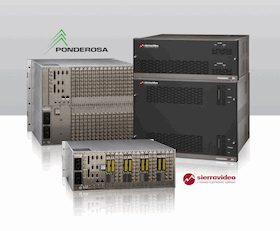
Sierra Video Ponderosa.In certain circumstances it makes "cents" to use photos (fiber) in place of electrons (copper). The first circumstance that comes to mind is often distance. Fiber can carry signals much greater distances than any copper based solutions (coax or twisted pair). Resistance to interference, such as, but not limited to, ground loops is another. Fiber also offers benefits in terms of space, as it is much smaller in diameter than coax. It is also more flexible and provides some future proofing. You can use it for video today and ethernet tomorrow if desired, and if we have 10G signals in the future, fiber is robust enough to carry such a signal, and copper is not. Fiber also offers more security, as it is more difficult to tamper with and is typically much lighter than copper solutions. For today's market though, a product that offers the ability to mix both fiber and copper solutions in one product is probably the ideal solution.
Caption:
Todd Kellison, sales engineer, and Alon Dagan, director, video product development, Opticomm:
Opticomm-EMCORE suggests four basic criteria to answer the question of when to use fiber cable and extenders or copper cabling as your transport medium: bandwidth, distance, security and quality, anddensity. Video-centric networks demand such large amounts of bandwidth, that fiber optic extension and switching makes perfect “cents” in these scenarios. Over the past few years there have been advancements in copper cabling, so it is now possible to send a 1080P HD signal 50 feet with out any major issues, however, once you pass the 50 foot threshold it becomes a challenge for even high-grade HDMI or DVI cables. In addition to fiber, there are other solutions that can eliminate standard copper video cables and extend high-resolution signals over CAT5/6 cables that are reasonably cost-effective, however, even the best CAT5 extender solutions in the market can only reach a maximum of 100 meters at uncompressed 1080P HD resolutions. To be realistic, at 50 meters a strong consideration should be given to using fiber. Fiber cable is less expensive per foot than copper cabling and has the added benefit of being much lighter weight, making it easier to install. In addition, due to the bandwidth capabilities and the lossless characteristics of fiber, there is no degradation in signal quality over any distance using fiber—whether 1 meter or 80 kilometers—whereas copper cabling has degradation even over a few meters. Since fiber is not an electrical conductor and therefore is immune to electromagnetic and radio frequency interference, it allows the highest quality and security possible for video, audio, and data signals transported between facilities, on campuses, or even from one room to another without information from the fiber being affected by outside sources of noise. If there are a large number of DVI signals (e.g. 32 high-resolution DVI signals to move and switch from one place to another) then you should strongly consider using fiber. In the market today, there are very few manufacturers that make large form copper DVI matrix switches greater than 32 by32, and the ones larger than that take up major rack space.
The AVNetwork staff are storytellers focused on the professional audiovisual and technology industry. Their mission is to keep readers up-to-date on the latest AV/IT industry and product news, emerging trends, and inspiring installations.
